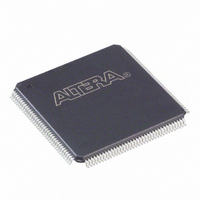EPF6016TC144-3 Altera, EPF6016TC144-3 Datasheet - Page 10

EPF6016TC144-3
Manufacturer Part Number
EPF6016TC144-3
Description
IC FLEX 6000 FPGA 16K 144-TQFP
Manufacturer
Altera
Series
FLEX 6000r
Datasheet
1.EPF6010ATC100-3N.pdf
(52 pages)
Specifications of EPF6016TC144-3
Number Of Logic Elements/cells
1320
Number Of Labs/clbs
132
Number Of I /o
117
Number Of Gates
16000
Voltage - Supply
4.75 V ~ 5.25 V
Mounting Type
Surface Mount
Operating Temperature
0°C ~ 85°C
Package / Case
144-TQFP, 144-VQFP
Lead Free Status / RoHS Status
Contains lead / RoHS non-compliant
Total Ram Bits
-
Other names
544-1282
Available stocks
Company
Part Number
Manufacturer
Quantity
Price
Company:
Part Number:
EPF6016TC144-3
Manufacturer:
ALTERA
Quantity:
48
Company:
Part Number:
EPF6016TC144-3
Manufacturer:
SANYO
Quantity:
47
Company:
Part Number:
EPF6016TC144-3
Manufacturer:
ALTERA
Quantity:
1 066
Part Number:
EPF6016TC144-3
Manufacturer:
ALTERA/阿尔特拉
Quantity:
20 000
Company:
Part Number:
EPF6016TC144-3N
Manufacturer:
ALTERA42
Quantity:
1 341
Part Number:
EPF6016TC144-3N
Manufacturer:
ALTERA/阿尔特拉
Quantity:
20 000
FLEX 6000 Programmable Logic Device Family Data Sheet
10
Carry Chain
The carry chain provides a very fast (0.1 ns) carry-forward function
between LEs. The carry-in signal from a lower-order bit drives forward
into the higher-order bit via the carry chain, and feeds into both the LUT
and the next portion of the carry chain. This feature allows the FLEX 6000
architecture to implement high-speed counters, adders, and comparators
of arbitrary width. Carry chain logic can be created automatically by the
Altera software during design processing, or manually by the designer
during design entry. Parameterized functions such as LPM and
DesignWare functions automatically take advantage of carry chains for
the appropriate functions.
Because the first LE of each LAB can generate control signals for that LAB,
the first LE in each LAB is not included in carry chains. In addition, the
inputs of the first LE in each LAB may be used to generate synchronous
clear and load enable signals for counters implemented with carry chains.
Carry chains longer than nine LEs are implemented automatically by
linking LABs together. For enhanced fitting, a long carry chain skips
alternate LABs in a row. A carry chain longer than one LAB skips either
from an even-numbered LAB to another even-numbered LAB, or from an
odd-numbered LAB to another odd-numbered LAB. For example, the last
LE of the first LAB in a row carries to the second LE of the third LAB in
the row. In addition, the carry chain does not cross the middle of the row.
For instance, in the EPF6016 device, the carry chain stops at the 11th LAB
in a row and a new carry chain begins at the 12th LAB.
Figure 5
with the carry chain. One portion of the LUT generates the sum of two bits
using the input signals and the carry-in signal; the sum is routed to the
output of the LE. Although the register can be bypassed for simple adders,
it can be used for an accumulator function. Another portion of the LUT
and the carry chain logic generates the carry-out signal, which is routed
directly to the carry-in signal of the next-higher-order bit. The final
carry-out signal is routed to an LE, where it is driven onto the FastTrack
Interconnect.
shows how an n-bit full adder can be implemented in n + 1 LEs
Altera Corporation














